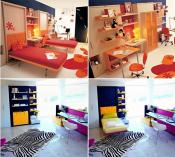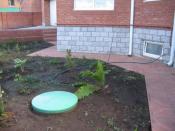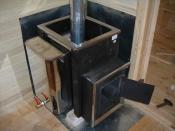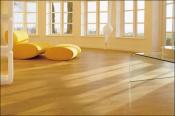Search
Login
Recommended
We build a house of brick
Russian houses are reliable and massive, and as they do not glorify new construction technologies, many continue to build houses of brick.
Content
- Brick is what? video
- Ordinary brick
- Front brick
- Brick in accordance with GOST
- Brick thermal conductivity
- Lightweight masonry
- Porous brick video
- The main mistakes when laying brick
Brick is what?
Since childhood, we all remember the fairy tale Three Little Pigs, the concept that the building must be reliable, stable has been firmly laid in our memory.
And the most reliable, in our understanding, building material is brick.
We believe that this is the strongest, warmest and fireproof material.
Let's look at this question in detail, is that so? But in fact, a brick is by no means a completely not warm material.
In order for the constructed house to meet modern standards in terms of thermal conductivity, the walls of such a building must have a thickness of 50 cm.
Regarding the fire safety of bricks, the statement is relative, since only refractory bricks hold fire well.
And only furnaces are built from refractory bricks, and building bricks, like all building materials (mainly), also lend themselves to flame.
But, whatever you say, a brick house is our blue dream.
The brick house has many advantages: it is easy to breathe in it, since the brick has excellent air exchange ability.
In brick houses, in the heat, it’s cool and our old people, mostly not having air conditioning, thanks to the brick houses, can endure abnormal heat.
Of course, not every elderly person has to live in a brick house (unfortunately).
If the builders did the right brickwork, it’s warm in such houses in winter.
Since brick is a natural product, it is able to regulate air humidity.
And in general, in our time of aggressiveness, in a brick house you feel safe.
Ordinary brick
Brick production varies in purpose and place of use.
When erecting walls and interior partitions, ordinary brick is used.
Ordinary brick, and therefore ordinary, because, as a soldier, high requirements apply to him.
And the main requirements of ordinary brick are high strength and frost resistance.
For such a brick, smoothness and beauty is not the main thing, because, in the future, it will be hidden from human eyes.
Front brick
Front brick has many different names.
You can call it facing, finishing, front, or decorative and you will not be mistaken.
In the production of facing bricks, observe tight tolerances in geometry and in various external defects. Facade front brick is smooth and textured, i.e. with embossed pattern.
Front brick can be glazed and engobed, i.e. covered with special clay.
Designers use a variety of brick colors, from light pink to black, make up very interesting design projects. The modern market presents a large assortment of plastic windows whose prices are not so high. The combination of beautifully shaped plastic windows with a variety of brick colors gives an individual look to the building.
Brick in accordance with GOST
All bricks, which are produced in Russia, are tested and marked in accordance with GOST: strength, frost resistance and thermal conductivity.
Strength shows the ability of a brick to resist internal stresses while remaining intact.
When building a house with a small number of storeys, brick of the M-100 and M-125 brands is usually used. This brick can withstand a load of 100 kg. per square centimeter and 125 kg. per square centimeter, in accordance with the marking.
What is frost resistance? This is the ability of a brick in a water-saturated state to withstand alternately freezing and thawing.
For our climatic conditions, this is especially true. When building houses, it is necessary to take a brick, brands of at least F50 (this brick can withstand 50 cycles of temperature changes from + to -), but it is better to take F75.
Ordinary and front bricks are produced in two types - corpulent and hollow.
Solid brick is suitable for laying columns, foundations, walls, i.e. for the erection of supporting structures. This brick has reinforced strength, well resists bending forces.
Hollow brick, the distinguishing ability of which is good thermal conductivity, this brick is also called effective.
It should be noted that Europeans do not coordinate brick production with Russian standards, therefore, when designing, it is necessary to take into account the exact dimensions of the brick.
Brick thermal conductivity
Lightweight masonry
In modern construction, there is a constant struggle for material that combines the main good quality indicators, and at the same time, has an acceptable cost.
The use of modern insulating materials reduces the weight of the structure, thereby reducing the load on the foundation and increasing energy efficiency.
Alternatively, a lightweight type of masonry, i.e. first, brick walls are laid out, and then the space between them is filled with heat-insulating backfills: expanded clay, perlite sand or poured with lightweight concrete.
Porous brick
In addition to traditional bricks, the construction market offers porous bricks.
Such a brick has a high thermal insulation ability.
This ceramic brick has a porous structure.
In the production of such bricks, clay is added to the clay base.
When firing a brick, sawdust burn out and form numerous small pores that are filled with air.
Such a brick has a special honeycomb structure in the form of hexagonal voids, thereby significantly increasing the heat efficiency of the brick.
When building a house, it is enough to erect the walls in one row of stones with a width of 510 mm., Plaster the walls and this is enough for a comfortable stay and economical fuel consumption.
But all the same, it is necessary to carry out a thermal insulation calculation, which takes into account local climatic conditions.
The main mistakes when laying brick
A brick house built in accordance with all the rules of construction technology will serve people for at least 200 years.
And mistakes in the performance of masonry, especially the supporting structures of the house, can lead to disaster.
The cracks that we see on brick houses are a consequence of poor-quality masonry walls.
One of the most common mistakes is poorly executed seams.
Sometimes combined defects are also found.
The first example of defects is the absence of seams or seams that are too thick.
When laying, it is necessary to observe the thickness of horizontal joints 12 mm.
When reinforced masonry, the horizontal thickness of the seam is not more than 16 mm. Vertical joints should not exceed 10 mm. The deviation in any direction is only 2 mm.
The second option: the first and last row of any masonry, according to the requirements of SNiP, should be poked, the reinforced concrete floor slab should always be laid on the mortar and not on the foam.
The third option: metal elements used in the form of jumpers, beams - must be protected from corrosion.
Otherwise, metal corrosion leads to brick corrosion.
The fourth mistake: all masonry joints must be well filled with mortar, otherwise, the strength of the walls and its bearing capacity are reduced.
In addition, in the voids, moisture condenses in winter, the heat capacity decreases and all this quickly destroys the walls.





